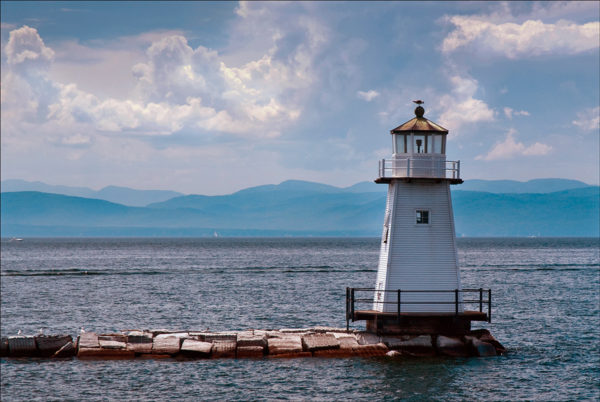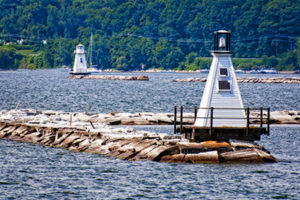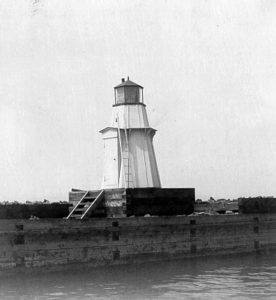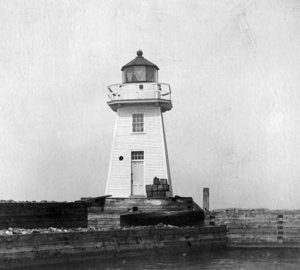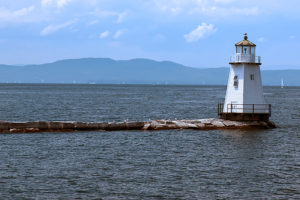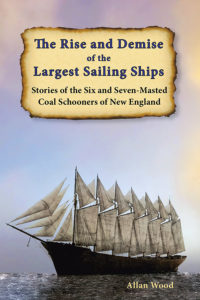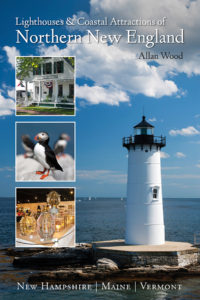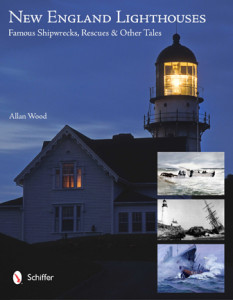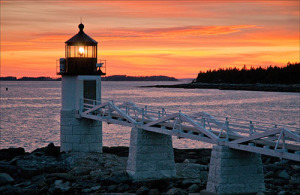Rescue of the General Butler by James Wakefield, Vermont’s Most Famous Keeper (Part 2)
The Expansion of Burlington’s Waterfront
There are over 300 shipwrecks on Lake Champlain. They vary from ships that had fought during the Revolutionary War to modern airplanes and powerboats. With the completion of the Champlain Canal, which connected the Hudson River and Lake Champlain, Burlington became the third largest port for lumber shipping and quarried stone, primarily from Vermont and Canada. The Burlington waterfront was built because of the increasing commercial traffic on Lake Chaplain. With this increasing shipping trade came the need for a breakwater to protect mariners from the constant weather changes and storms. Canal boats brought in most of the stones used to build the breakwater. These boats helped to make the connection with the Hudson River leading into New York City, which helped Burlington develop as a world trade port.
A 1,000-foot breakwater was completed in 1854 and gradually extended as the waterfront grew. By the late 1800s, the breakwater had grown to nearly 4200 feet long. Wooden lighthouses were first placed on both ends of the breakwater in 1857, known as the Burlington Breakwater lights. Over the years, the wooden structures could not survive the constant elements of strong winds, ice, and even fires. In 1870, the northern lighthouse burned to the ground, and in 1876, a fierce storm knocked over Burlington’s southern light.
In 1875, a keeper’s dwelling was built on the breakwater, but being only a mile from the waterfront, the keepers preferred to live in the city with their families and would remain ashore. They would row out to each small lighthouse to tend them when needed. It sometimes became a challenge for them to row out to the lights on those days when rough weather, which occurred quite frequently, covered the area. The keeper’s house remained unoccupied for nearly ten years before being auctioned off and moved ashore.
Vermont’s Famous Keeper
One of the most incredible rescue stories in the region involves the wreck of the General Butler. At this time, the government frowned upon and sometimes removed those keepers who attempted to make additional income from other occupations. James Wakefield was not only the lighthouse keeper of the Burlington Breakwater Lights who lived on the shore with his family but also had a very successful business repairing ships allowed by the government.
Before James Wakefield became Burlington’s lighthouse keeper, he had spent many years as a sailor and a second mate to captains on voyages transporting cargo worldwide. He was a large, muscular man born in 1829. He was no stranger to rescuing crew members, saving distressed vessels during severe storms and hurricanes, and handling drunk and unruly captains.
After deciding to retire from the harsh conditions of being an officer and a sailor, Wakefield spent some time in New York near his brother. In 1857, he chose to stay in Burlington, Vermont, where he developed a prosperous business in making and repairing sails and dealing in ship supplies as a ship chandler. His business grew, and he became popular for his honesty and fairness, as well as his maritime knowledge.
The Heroic Rescue of the General Butler
The vessel, the General Butler, was named after General Benjamin Butler, a hero of the Civil War. She was an 88-foot-long canal or cargo boat built in 1862 and was designed to sail and travel through the Lake Chaplain Canal system. Captain William Montgomery was the third owner of the vessel and lived on the Isle La Motte, located in northern Vermont. On December 9, 1876, the General Butler was heading out from Fisk Quarry on the Isle La Motte with 30 tons of marble and stone to Burlington’s manufacturing shed. On board were a crewman, a quarryman with an eye injury going for medical treatment, and two teenage girls, the captain’s teenage daughter and the other her friend.
On that December day, as the General Butler sailed towards Burlington, a powerful winter gale storm was approaching and came full force upon them as they came towards Burlington Harbor. The rigging started to tatter. Suddenly, the steering mechanism broke on the vessel, causing it to be tossed around the thrashing waters near the Burlington breakwater. Captain Montgomery dropped anchor to try to jury-rig the tiller bar to the steering post to gain enough momentum to steer the vessel into the harbor. Still, the waves were too much, and the anchor started dragging across the sandy bottom. The attempt to fix the steering failed, and he was forced to cut the anchor line, causing the ship to drift helplessly toward the southern end of the breakwater. The enormous waves caused by the gale force winds were too much for the vessel, forcing the ship on top of the jagged stone breakwater. Captain Montgomery knew the boat was about to sink with its heavy stone cargo in the icy waters and convinced all aboard that they had to jump the ship onto the ice-covered rocks until help arrived. One by one, he helped them off the boat onto the breakwater and was the last one himself to jump off. A few seconds later, the General Butler, with her heavy load of stone, slipped off the breakwater and sank 40 feet into the icy bottom.
The five survivors were now in another perilous position, drenched as the waves washed over the breakwater and freezing from exposure. The survivors were still about a mile out in the breakwater, which was not connected to the shore, and swimming to safety would have been impossible in the icy waters. A large crowd had gathered by the waterfront and watched the incident unfold. There were many able-bodied men and old sea captains, but no one wanted to venture out and risk their own lives in the gale-force winds and raging waves. Now in his late 40s, James Wakefield ran towards the waterfront with his son to investigate. Upon seeing the figures of the survivors on the stone structure, he knew they would freeze to death if help did not come quickly. He returned to the lighthouse and secured the small 14-foot government lighthouse boat. He and his son launched the boat amid the onlookers and started the daunting task of trying to row the craft to reach the breakwater a mile away against the ferocity of the winds and pounding waves. Wakefield and his son finally got to the breakwater exhausted but determined to save them all from their perilous fate. The captain of the vessel grabbed his daughter Cora and her teenage friend and placed them first into the strong arms of the old sailor. Then, each of the three remaining crew jumped into Wakefield’s boat one by one. Again, the captain came last, ensuring all were accounted for in the tiny craft.
With all their strength, Wakefield and his son pulled the boat through the violent waters and winds and safely brought everyone ashore to a welcoming crowd. Captain Montgomery’s daughter, Cora, and the others received medical treatment once they were given dry clothes and regained their senses.
When she recovered from the ordeal, Cora asked to return to Burlington and be present when the vessel would be raised, but the request never came about as the General Butler lay beneath the waves for eternity. That night, when the ship finally came to rest on the lake’s sandy bottom, she lay about 75 yards west of the southern end of the breakwater. What is also interesting about this rescue is that although James Wakefield, as the local lighthouse keeper, successfully rescued the crew, the Burlington Breakwater South Lighthouse near where the wreck occurred was inoperable from a previous storm and was awaiting repairs. So, there was no illumination from the south end of the breakwater to help the keeper in his efforts. He could rely on his knowledge of the area to maneuver the boat to the survivors. All the survivors recovered, and James Wakefield and his son became the local heroes of Burlington. The vessel was a total loss and had been uninsured from the year before the incident, so no funds were left to raise her.
The First Shipwreck for Lake Champlain Divers
The General Butler can easily be viewed by divers and on shipwreck excursions by the Lake Chaplain Museum. The wreck of the General Butler became the first shipwreck in the Vermont Underwater Historic Preserve program. The vessel’s hull is still intact, and none of the interior has collapsed. The cargo hatches that were carrying the marble were easily viewable.
Exploring Burlington’s Waterfront
Burlington is Vermont’s largest city, offering its many events, specialty shops, restaurants, artist’s galleries, and museums, especially along the streets of The Church Street Marketplace. There are also plenty of trails for bikers and hikers inside the city and along Burlington’s Waterfront Park. Burlington’s Waterfront Bike Path is an 8-mile route along Lake Champlain’s shoreline.
Explore the Lake Champlain Maritime Museum to learn about Lake Champlain’s history through hands-on exhibits, shipwreck discoveries, and viewing full-scale replicas of the ships that navigated these waters. They also offer shipwreck tours, like the General Butler, and exhibit artifacts from the wreckage of many vessels.
The Spirit Of Ethan Allen III is Burlington’s passenger ship that goes past the Burlington Breakwater lighthouses on their Scenic Narrated Cruises. Cruises are offered daily during summer, taking you around Burlington’s Lake Champlain islands.
Enjoy!
Allan Wood
Books to Explore
The Rise and Demise of the Largest Sailing Ships: Stories of the Six and Seven-Masted Coal Schooners of New England. In the early 1900s, New England shipbuilders constructed the world’s largest sailing ships amid social and political reforms. These giants were the ten original six-masted coal schooners and one colossal seven-masted vessel, built to carry massive quantities of coal and building supplies and measured longer than a football field! This self-published book, balanced with plenty of color and vintage images, showcases the historical accounts that followed these mighty ships.
Available also from bookstores in paperback, hardcover, and as an eBook for all devices.

Book – Lighthouses and Coastal Attractions in Southern New England: Connecticut, Rhode Island, Massachusetts
Lighthouses and Coastal Attractions of Southern New England: Connecticut, Rhode Island, and Massachusetts. This 300-page book provides memorable human interest stories from each of the 92 lighthouses. You can explore plenty of indoor and outdoor coastal attractions, including whale-watching excursions, lighthouse tours, windjammer sailing tours, parks, museums, and even lighthouses where you can stay overnight. You’ll also find plenty of stories of hauntings around lighthouses.
Lighthouses and Coastal Attractions of Northern New England: New Hampshire, Maine, and Vermont. This 300-page book provides memorable human interest stories from each of the 76 lighthouses, including James Wakefield’s rescue of all the crew of the General Butler. It also describes and provides contact info for plenty of indoor and outdoor coastal attractions and tours. These include whale watching, lighthouse tours, unique parks, museums, and lighthouses where you can stay overnight. There are also stories of haunted lighthouses in these regions.
New England Lighthouses: Famous Shipwrecks, Rescues & Other Tales contains over 50 stories, including the legacy of James Wakefield, and the rescue of the crew of the General Butler. This image-rich book also contains vintage images provided by the Coast Guard and various organizations and paintings by six famous Coast Guard artists.
You can purchase this book and the lighthouse tourism books from the publisher Schiffer Books or in many fine bookstores such as Barnes and Noble.
Copyright © Allan Wood Photography, do not reproduce without permission. All rights reserved.
Join, Learn, and Support The American Lighthouse Foundation
